|
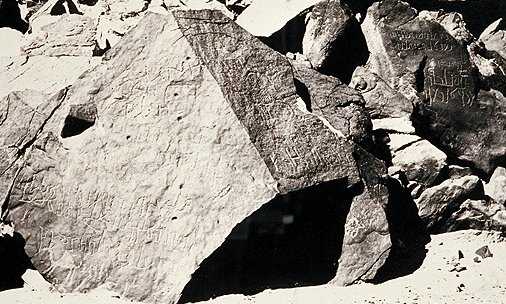
- Click on above
picture to enlarge
-
- Sinaitic
Inscriptions in Wadee El-Mukattab, Sinai
- Above Inscription
shot in 1857 by Francis Frith (1822-1898)
- BOOK TITLE: Sinai,
Palestine, The Nile. ca. 1863
Below
from Sinai Inscriptions found
- Exodus from Egypt?
| Compare Moses' description in
the Bible below about the events surrounding the escape from
Egypt, with the following 8 ancient inscriptions found on
different cliffs in the Wadi Sidra area of the Sinai.
Wadi
Sidra is a possible natural route the Jews may have chosen in the
Sinai after escaping Egypt. The exact route remains
uncertain.
|
Inscriptions BEGIN:
"The wind blowing, the sea dividing into parts,
they pass over"
"The Hebrews flee through the sea; the sea is
turned into dry land."
"The waters permitted and dismissed to flow, burst
rushing unawares upon the astonished men, congregated from
quarters banded together to slay treacherously being lifted
up with pride."
"The leader divideth asunder the sea, its waves
roaring. The people enter, and pass through the midst of
the waters."
"Moses causeth the people to haste like a
fleet-winged she-ostrich crying aloud; the cloud shining bright,
a mighty army propelled into the Red sea is gathered into
one;
they go jumping and skipping.
Journeying through the open channel,
taking flight from the face of the enemy.
The surge of the sea is divided."
"The people flee, the tribes descend into the deep.
The people enter the waters.
The people enter and penetrate through the midst.
The people are filled with stupor and perturbation.
Jehovah is the keeper and companion."
"Their enemies weep for the dead, the virgins are
wailing.
The sea flowing down overwhelmed them.
The waters were let loose to flow again."
The people depart fugitive.
A mighty army is submerged in the deep sea,
the only way of escape for the congregated people."
Inscriptions END
Above
found in Grant R. Jeffrey's "The Signature of
God"
Historian Diodorus
Siculus, about 10 B.C. described the Sinai Peninsula in
his Library of History wrote, "Moreover, an
altar is there built of hard stone and very old in years,
bearing an inscription in ancient letters of an unknown
tongue. the oversight of the sacred precinct is in the care
of a man and woman who hold the position for life."
(Bk. 3, sect. 42, Loeb Classical Library, C.H. Oldfather,
trans. [Cambridge Harvard University Press, 1993], p.211)
In 518 A.D.
Cosmas Indicopleustes, a Byzantine Christian writer, also
mentions the ancient inscriptions. Concerning them he
stated that they appeared "at all halting places, all
the stones in that region which were broken off from the
mountains, written with carved Hebrew characters."288/49
Cosmos came to the conclusion that they were made by the
Israelites fleeing Egypt.
Other
explorers which confirmed these inscriptions were Bishop
Robert Clayton of Ireland (1753) and Rev. Charles Forster
who published these findings in a book in 1862. He came to
the conclusion that these inscriptions were a combination
of both Hebrew and Egyptian alphabets describing Israelís
exodus out of Egypt.
In 1761 a
German explorer Barthold Niebuhr found an extensive ruined
cemetery grave site of Jews which was discovered in the
Sinai with inscriptions confirming they died as a result of
Yehovahís supernatural plague mentioned in Numbers
11:34-35.
-The writers of those
inscriptions which vividly describe the major events of the
Exodus do not use any of the words or language that Moses
uses to describe the same. In other words, they are
obviously not inspired by Moses' writings. They are plainly
written in the context of independent witnesses to these
events.
Josephus in Josephus
Against Apion. I, 26, 27, 32 mentions two Egyptian
priest-scholars: Manetho and Cheremon who in their
histories of Egypt specifically named Joseph and Moses as
leaders of the Jewish race. Josephus states that Manetho
and Cheremon stated that the Jews rejected Egyptís
customs and gods. They noted that the Jews practiced animal
sacrifices which they witnessed on the first Passover.
These historians also confirmed that the Israelites
migrated to "southern Syria" which was the
Egyptian name for Palestine. They also mentioned that
Israelís exodus occurred during the reign of Amenophis who
was the son of Rameses and the father of Sethos who reigned
toward the close of the 18th dynasty which places the
Israelites exodus between 1500 and 1400 BC. This confirms
the Old Testamentís chronology for the exodus occurring in
1460 BC.
SANDSTONE INSCRIPTIONS
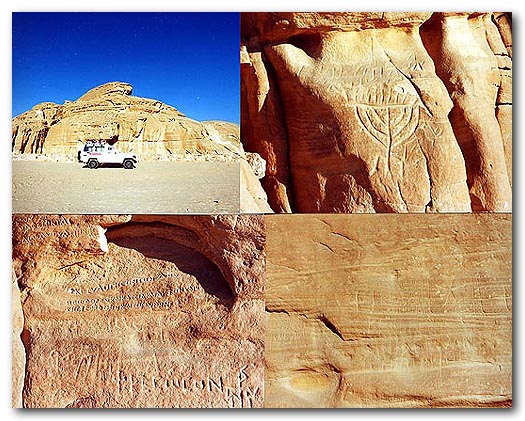
So what
happened to the bodies of all the Hebrew escaped slaves
who died from this plague? A mountaintop Graveyard
found.
In 1761, Barthold Niebuhr, a
German explorer, found a huge cemetery with tombs and a
sepulcher atop an inaccessible mountain called
Sarbut-el-Khaden. Inscriptions were found on the tombs
and inside the sepulcher. (Voyage en Arabie, tom. i. p.
191). Niebuhr offered his doubts that the inscriptions
were made by Egyptians as no carved inscriptions were
ever found in Egypt; rather they were partial to
painting images on plaster. He also found legible
inscriptions not only on the tombs but also within a
small temple carved out of rock, all found to be of the
same written language as the Hebrew Exodus inscriptions.
In another book, Niebuhr remarked "the wonderful
preservation of the inscriptions upon this soft
sandstone, exposed as they have been to the air and
weather during the lapse of so many ages. On some of the
stones they are quite perfect" (Niebuhr, Biblical
Researches, vol. i. pp. 113-114). He found, as in the
other Sinai inscriptions, that the hieroglyph-like
writings were significantly different in form from
Egyptian hieroglyphics, yet sharing similarities
nonetheless. Also, no mention of Egyptian gods or common
Egyptian symbols are to be found in the mountain-top
graveyard.
In addition to all of this,
Niebuhr found numerous engravings of quails on the
tombstones "standing, flying and apparently, even
trussed and cooked" (Rev. Charles Forster, Sinai
Photographed [London: Richard Bentley, 1862], p. 62) and
noted that the Bedouins refer to this graveyard as the
"Turbet es Yahoud" (grave of the Jews).
When Dr. Stewart later later
explored this huge graveyard, he made molds of the
inscriptions there which were later translated by Rev.
Charles Forster to appear in his 1962 book Sinai
Photographed (p. 84):
-The apostates smitten with disease by God, by
means of feathered fowls.
-Smitten by God with disease in the sandy plain, (when)
exceeding the bounds of moderation.
-Sickening, smitten by God with disease; their
marrows corrupted by God by means of the feathered
fowls.
-The people, given over to destruction, cry aloud.
-God pours down deep sleep, messenger of death, upon the
pilgrims.
-The tomb is the end of life to the sick, smitten with
disease by God."
Miriam's Rebellion (inscriptions found)
-Miriam, Prophetess of lying lips an deceitful tongue.
-She causes the tribes to conspire against the pillar
and prince of the people.
-Convoked for tumult, perverted, full of strife, the
people revile the meek and generous man.
-They lead with reproaches the blessed one of God.
-The Plague of Fiery Serpents
-Bitten and destroyed by fiery, hissing serpents, the
Hebrews are wounded for their crimes.
-Jehovah makes a stream flow from the stony rock.
The people, given over to destruction, cry aloud.
God pours down deep sleep,
messenger of death, upon the pilgrims.
The tomb is the end of life to the sick,
smitten with disease by God."
Other
inscriptions:
-The Hebrews Murmur Against Moses / God Provides Water
Miraculously.
-Pilgrims fugitive through the sea find a place of
refuge at Sidri.
-Lighting upon plain ground they proceed on their
pilgrimage full of terror.
-The Hebrews pass over the sea into the wide waterless
desert, famishing with hunger and thirst.
-The people clamor vociferously. The people anger Moses.
-Swerving from the right way, they thirst for water
insatiably.
-The water flows, gently gushing out of the stony rock.
-Out of the rock a murmur of abundant waters.
-Out of the hard stone a springing well.
-Like the wild braying, the Hebrews swallow down
enormously and greedily.
-Greedy of food like infants, they plunge into sin
against Jehovah.
-The people drink, winding on their way, drinking with
prone mouth,
-Jehovah gives them drink again and again.
-The people sore athirst, drink vehemently.
-They quaff the water-spring without pause, ever
drinking.
-Reprobate beside the gushing well-spring.
-God Judges The People's Gluttony.
-The people have drink to satiety. In crowds they swill.
-Flesh they strip from the bone, mangling it.
-Replete with food, they are obstreperous.
-Surfeited, they cram themselves; clamoring, they vomit.
-The people are drinking water to repletion.
-The tribes, weeping for the dead, cry aloud with
downcast eyes.
-The dove mourns, devoured by grief.
-The hungry ! ??? the tempted men, brought to
destruction, perish. Apostasy from the faith leads them
to the tomb.
-Devouring flesh ravenously, drinking wine greedily.
-Dancing, shouting, they play.
-Congregating on all sides to ensnare them, the people
voraciously devour the quails.
-Binding the bow against them, bringing them down.
-Eagerly and enormously eating the half raw flesh,
the pilgrims become plague-stricken.
Moses' description in
the Bible
Exodus 12:31-42
31 During the night Pharaoh summoned Moses and Aaron and said,
"Up! Leave my people, you and the Israelites! Go, worship the
Lord as you have requested. 32Take your flocks and herds, as you
have said, and go. And also bless me."
33 The Egyptians urged the people to hurry and leave the country.
"For otherwise," they said, "we will all die!"
34 So the people took their dough before the yeast was added, and
carried it on their shoulders in kneading troughs wrapped in
clothing. 35 The Israelites did as Moses instructed and asked the
Egyptians for articles of silver and gold and for clothing. 36 The
Lord had made the Egyptians favorably disposed toward the people,
and they gave them what they asked for; so they plundered the
Egyptians.
37 The Israelites journeyed from Ramses to Succoth. There were about
six hundred thousand men on foot, besides women and children.38 Many
other people went up with them, as well as large droves of
livestock, both flocks and herds.39 With the dough they had brought
from Egypt, they baked cakes of unleavened bread. The dough was
without yeast because they had been driven out of Egypt and did not
have time to prepare food for themselves.
40 Now the length of time the Israelite people lived in Egypt was 430
years. 41 At the end of the 430 years, to the very day, all the
Lord's divisions left Egypt. 42Because the Lord kept vigil that
night to bring them out of Egypt, on this night all the Israelites
are to keep vigil to honor the Lord for the generations to come.
|
|
Chariot Wheels found in the Red Sea
(Gulf of Aqaba)
|
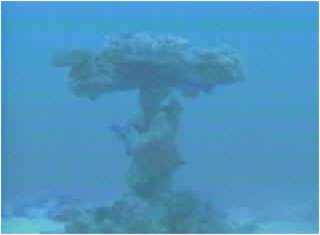 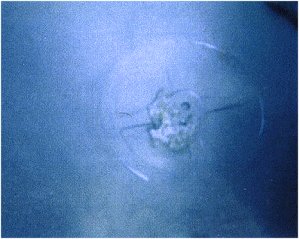
|
| Above left,
chariot wheel fixed to axels standing at
attention on the seabed. Above right a
4-spoked chariot wheel on the Red Sea seabed.
Found in 1998. |
The Bible said all the
chariots of Egypt and 600 choice chariots, or gold
veneered models, were in the army pursuing God's people.
|
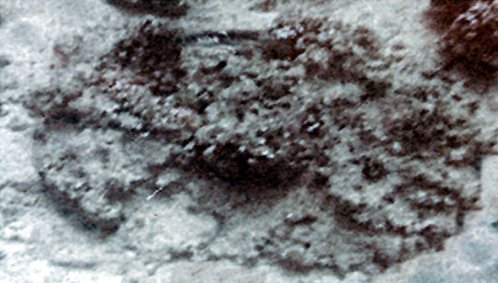 - above wheel shown
encrusted in coral
-
Above Chariot Wheel found
by Ron Wyatt in the Red Sea
an 8-spoked wheel/18th
dynasty only
|
|
Cairo
Museum Shows an 8-spoke wheel on a Chariot Cab
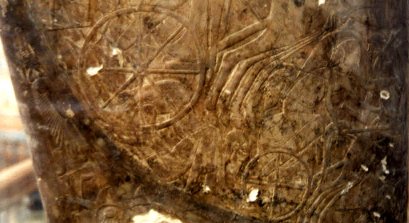
|
|
Go to the
Wyatt Archeological Research Center and read the
fascinating findings of this extraordinary archeologist
Ron Wyatt:
read: Where
was the Red Sea Crossing?
|
|
|
|
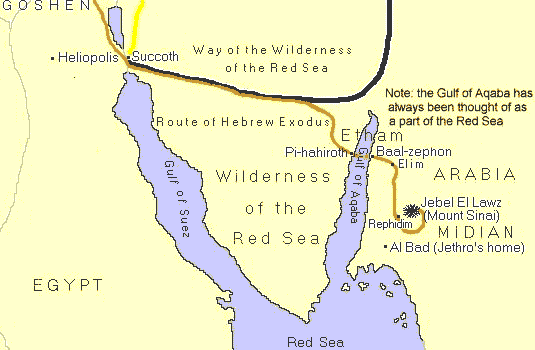
beach at Nuweiba
leads to Wadi Watir

Wadi Watir
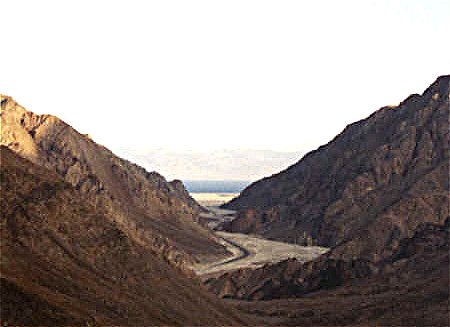 - click to enlarge
| In
describing his favorite places, Terri
Hurley wrote about Wadi Watir: The Sinai is
a mountainous desert, and the Bedouin travel
through, along, and over the ridges between the
mountains. The sun is not up for very long in
any wadi, because of the mountains, and it is
important not to camp on the soft sand in the
center of a wadi, because each one may drain as
much as 100 square miles of desert, and even
with no clouds visible, a wall of water can
barrel down the Wadi at any moment! The
view of the stars is unimaginable. 100+ miles
from the nearest electric light bulb, the sky
takes on an entirely new appearance. It doesn't
take more than 2 minutes between shooting stars,
and even with no moon, the light is bright
enough to walk around.
|

|

|
|
bones |
rib cage |
|

|
|
human
femur found in Red Sea |
Aaron Sen has dived on several occasions at this site, and can
testify to the validity of the discovery. In March 1998, he photographed the remains of a
four spoke chariot wheel, and has taken up human bones of which there are 'dozens'
scattered on the sea bed. One specimen was taken to the Department of Osteology at
Stockholm University, and tested, proving to be a human, male,
right side femur. Although it cannot be dated, it was evidently from
ancient times. The man's height was estimated at 165-170cm (5.4-5.5
feet), and the bones had been replaced by minerals. Tiny amounts of
coral were growing off the mineral replacement. Aaron has seen the drop
off of the southern end of the underwater land bridge. He has also seen
a pathway that the Israelites would have cleared in order to cross the
Red Sea, leading from the shore, descending into the sea. The
Israelites would have had to push the stones and rocks aside in order
to allow access for their wagons.
|
|












